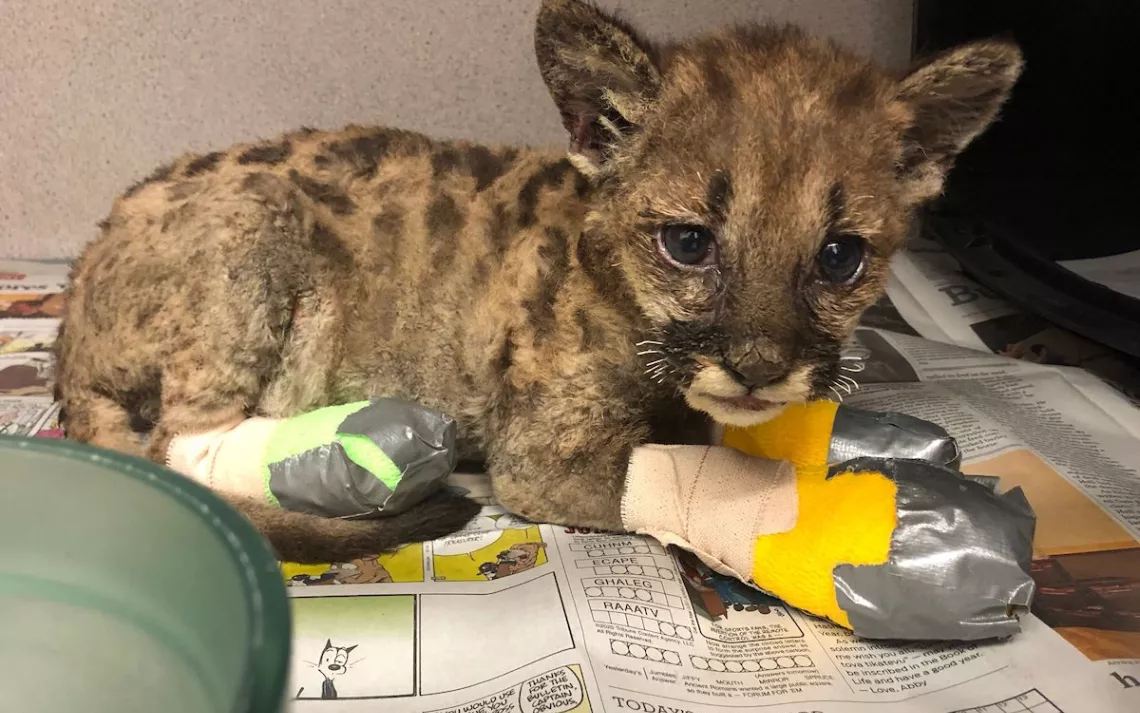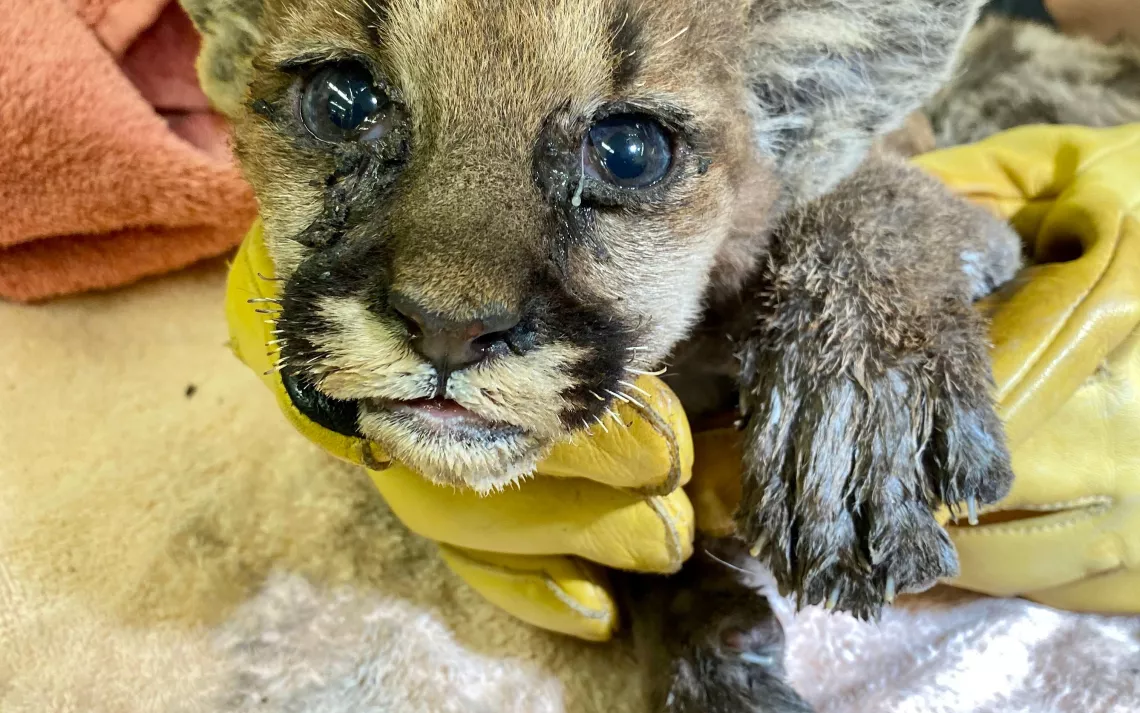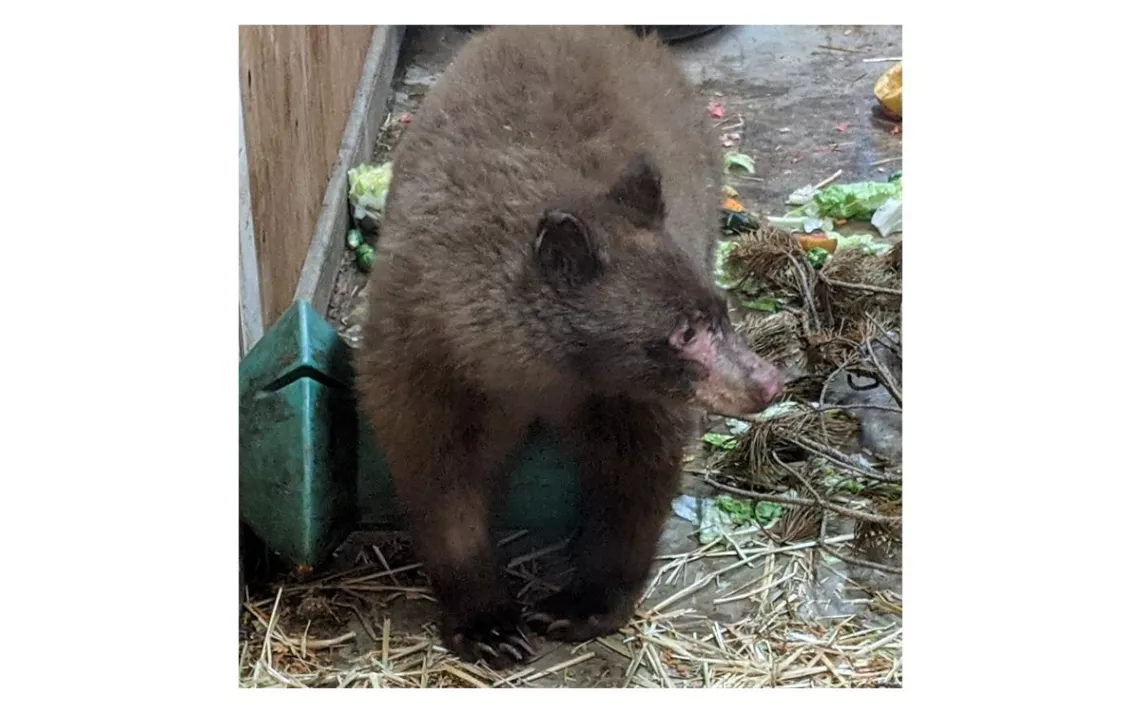California’s Wildest Wildfire Victims
Inside the state’s pioneering new Wildlife Disaster Network

Photo above courtesy of Oakland Zoo. Bear photo below courtesy of Denise Upton/Lake Tahoe Wildlife Care.
Captain Cal, a baby mountain lion, was only four to six weeks old when the Zogg Fire tore through northwestern California last fall, separating him from his mother. Whether she was killed by the inferno or simply unable to find her lost cub among the destruction is unknown, but the firefighters who found Cal just outside Redding—bone peeking through burned toes, whiskers singed to their roots—felt he deserved a chance at survival.
In the ashes of California’s devastating wildfires, new hope has emerged for its frequently forgotten victims: the wild animals. Like humans, pets, and livestock, wildlife is also facing an unprecedented challenge from the uptick in fires’ frequency and ferocity, but until the creation of the Wildlife Disaster Network (WDN) last October, animals like Captain Cal had no formal means of getting help.
“This is the first year that people are recognizing that wildlife is an important group that needs to be looked at when there are disasters occurring,” says Dr. Jamie Peyton, a critical care specialist and chief of the Integrative Medicine Service at the UC Davis veterinary hospital, which developed this program in conjunction with the California Department of Fish and Wildlife (CDFW). Peyton was inspired during a trip to Australia with her husband during the 2019 bushfires, during which they worked with groups responding to wildlife in need. She says that it evidenced the gap in disaster response for wild animals in her home state of California.

Firefighters and first responders understandably prioritize human need, which is often so severe that there isn’t even time to save pets, let alone to catch scared and injured wild animals. “The previous philosophy used to be that wildlife would get out of the way [of fires],” Dr. Peyton explains, adding that first responders were historically instructed to leave animals where they found them, because they would be fine. “But that’s not the truth. When they’re injured, they can’t do their normal activities; they’re in areas of severe drought, and all their food sources are gone.”
There is minimal data on wildlife response to wildfires in the past, but with the massive growth of California’s fires in recent years, it’s safe to surmise that even a natural response to the devastation wouldn’t suffice during recent years’ unprecedented megafires. When asked how impactful wildfires are on wildlife death, Captain Cal’s primary caretaker at the Oakland Zoo, Dr. Alex Herman, stressed the need for more data. “The increasing intensity and frequency of the wildfires are likely causing the death of many lions. There is a big uptick in finding burned wildlife, but no study has been done yet.”
It was through the WDN that Captain Cal was able to find refuge at the Oakland Zoo, which subsequently took in two other orphaned lions—a pair of sisters—shortly after his intake. In fact, predators seem to be the most common immediate victims of the fires. “Between bears, mountain lions, bobcats, coyotes, foxes—and one possum—those have been the ones that we’ve found the most,” says Dr. Peyton.

When an injured animal is discovered, first responders throughout California can now reach out to the WDN, which is made up of veterinarians from UC Davis (including the Oiled Wildlife Care Network) working in conjunction with veterinarians and biologists from the CDFW. By traveling to incident command centers and speaking directly with Cal Fire, Dr. Peyton’s team was able to alert first responders to the availability of the program’s services, which dispatches trained animal caretakers (often themselves) to rescue injured wildlife and coordinate care for them.
This was how a young black bear was able to survive the Zogg Fire this year. The terrified cub treed herself in the burned wasteland after her mother either died or disappeared. After three days, the team was able to get her down, transport her into care, and treat her injuries at a rehab facility.
Dr. Peyton sentimentally described the baby bear’s story: “There were burns to all four feet and her face, her eyes were swollen shut, and her ear tips were all burned off. It was really sad to see. Emotionally, these animals have been through trauma, including typically being separated from their mother.” The cub’s burns were attended to through a groundbreaking new treatment pioneered by Dr. Peyton, in which tilapia skin is grafted onto burned skin. This procedure has allowed this cub (pictured, right) to continue rehabilitating at Lake Tahoe Wildlife Care, which houses other orphaned bears with which she can socialize properly before being released. It was there that they decided to name the little black bear Peyton, in honor of her savior.
While the 2020 wildfire season has seen the largest number of wildlife being assisted thanks to the WDN, Dr. Peyton warns that this is only the beginning. “These natural disasters aren’t that natural. We’re infiltrating the landscapes, people are setting fires,” and as climate change continues to get worse, wildlife habitats will drastically change.
The shifting circumstances necessitate a new approach to disaster response that incorporates wild animals. “It’s not that we don’t go through the other phases of helping people and companion animals, but [the point is] to bring wildlife into that picture,” Dr. Peyton explains. “We can’t leave these animals that survive and are injured. They need our assistance. It’s not like they’re sitting out there for days. It can be weeks that they’re suffering from their injuries. We just found one a week ago, two months after the fire.” In the aftermath of fires, citizens can also help by calling 800-942-6459 if they spot wildlife in need, or by donating directly to the program.
Today, Captain Cal the mountain lion and Peyton the black bear are living proof that a networked response to California’s wildfires can save the lives of wild animals. The threat of climate change may be more impending than ever, but there is now more of a chance that wildlife can face it head on.
 The Magazine of The Sierra Club
The Magazine of The Sierra Club



